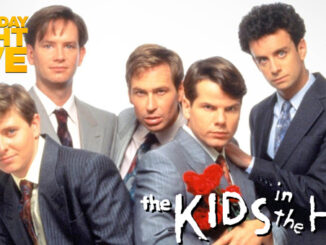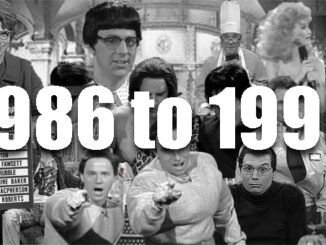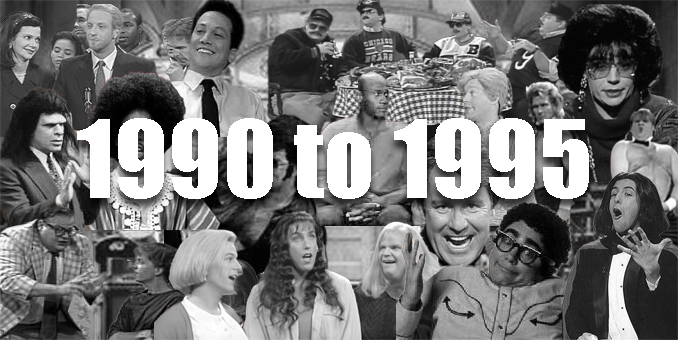
In honor of Saturday Night Live‘s 50th Anniversary, we will be going through its rich and varied history and breaking down its legendary run into easy to digest eras. Some eras might last for years, others only one season. But each era is one that either marked a change in the show, were driven by a remarkable personality of a star, or marked a special part of the history of the program. Today, we see an influx of young comedians who changed SNL in their image–and almost got the show cancelled.
Adam Sandler. Chris Farley. Chris Rock. Legendary names in comedy. Kings of the cineplex and the concert stage. All started Saturday Night Live at the same time, along with such notable names as Rob Schneider, David Spade and Tim Meadows. Looking back, taking into consideration what these people went onto become, you might think their time on SNL would be dead solid perfect, a high point of the show’s run.
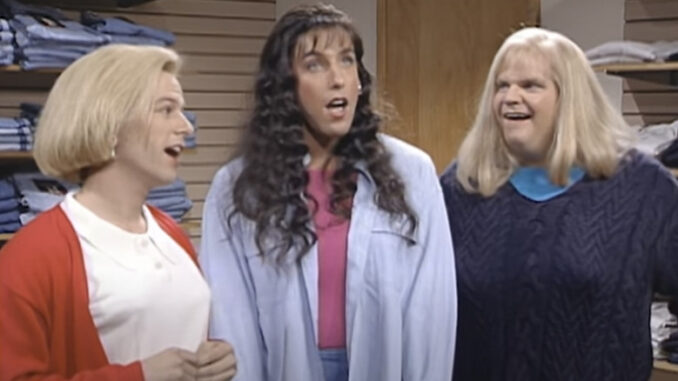
It wasn’t. Most of the above were fired from the show by NBC in effort to save it.
When Nora Dunn and Jon Lovitz left the show after its 15th season, Lorne Michaels believed he had a plan in place. He would bring young blood in to replace them, having the rookies learn with the veterans in the cast, just like he did with Mike Myers. It worked well with Myers, it should work well now.
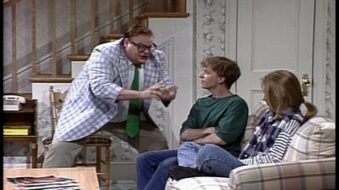
Spade and Schneider were members of the writing staff during season 15, so Michaels gave them a promotion to become featured players. Both came from the world of standup, as did Rock, who joined the show in a new category of actor: a “middle player.” He was joined as middle player by Julia Sweeney, a graduate of Los Angeles’ the Groundlings and Meadows and Farley, who came in from Second City in Chicago. Sandler joined in the middle of season 16, known for small roles in films and TV shows, mostly notably MTV’s Remote Control.
All the new additions made the cast increase by almost 50%. It changed Michaels’ masterplan from masters teaching student into a fight for airtime, a fight that favored the young newcomers.
The balance kept shifting as members of the old guard left the show and new replacements were brought on. Season 16 was the last season for Jan Hooks, A. Whitney Brown and Dennis Miller, the latter who was replaced as Weekend Update anchor by Kevin Nealon. New cast members included Ellen Cleghorne, Melanie Hutsell, Siobhan Fallon and Beth Cahill.
 Fallon and Cahill would be fired after one year. Michaels would not replace them. Mid-way through season 18, Dana Carvey left. At the end, Chris Rock left. As typical of the show’s treatment of comedians of color up to that time, he wouldn’t get airtime unless he played in stereotypical sketches like “The Dark Side with Nat X” or “I’m Chillin’.” He left SNL to join their competitor, In Living Color.
Fallon and Cahill would be fired after one year. Michaels would not replace them. Mid-way through season 18, Dana Carvey left. At the end, Chris Rock left. As typical of the show’s treatment of comedians of color up to that time, he wouldn’t get airtime unless he played in stereotypical sketches like “The Dark Side with Nat X” or “I’m Chillin’.” He left SNL to join their competitor, In Living Color.
This was also the season where Sinead O’Connor tore up the picture of the Pope, an event that Rich spoke about here.
Carvey and Rock were replaced in season 19 by Norm Macdonald, Jay Mohr, Sarah Silverman and Michael McKean.
SNL‘s ratings started to dip during this season. The comedy stylings of Sandler, Farley and rest of the “Bad Boys of SNL” had an effect on audiences. The humor in the show became cruder and louder. It might have resonated with younger audiences, but overall ratings were dropping. It was still one of the highest rated shows in late night, but it did catch the network’s executives’ notice, Don Ohlmeyer in particular. That became a problem.
Another problem was that season 19 was the last of Phil Hartman, Melanie Hutsell, Rob Schneider, Sarah Silverman and Julia Sweeney. With Hartman’s departure, Kevin Nealon was the only cast member from the previous era left. He was rewarded for his loyalty by having Weekend Update taken away from him and given to Norm MacDonald.
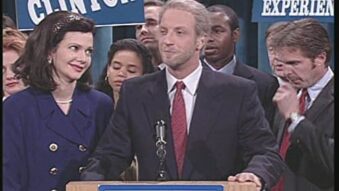
Michaels, perhaps trying to move away from the frat boy attitude that was dominating the show, hired the older, more established Chris Elliott and Janeane Garafolo to replace Hartman and company (they also hired Laura Kightlinger and, later, Morwenna Banks, Mark McKinney and Molly Shannon). Elliott and Garafalo were established comedians with long list of credits between them. Both were an absolutely horrible fit for the show.
Elliot was a master of goofy, esoteric humor on display in his on-camera appearances while serving as a writer for Late Night with David Letterman, and creating and starring in the sitcom Get a Life and the film Cabin Boy. Elliot, by his own admission, had a hard time working in the structure of Saturday Night Live, where he had to lose himself in a character instead just making himself the character.
Garofalo had the opposite problem–SNL wasn’t structured enough. She had experience with sketch comedy before with The Ben Stiller Show. But this was sketch comedy done the way Stiller preferred, the reason why he left SNL years before, to be filmed and tightly scripted, done with friends who were open to her ideas. SNL to her was a cliquish, dog-eat-dog boys club where she would be yelled at for trying to memorize her lines instead of just using the cue cards. She wasn’t happy, and she let the press know it. She wouldn’t last the full season.
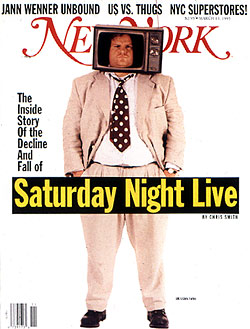
Then there’s the New York piece. The March 13, 1995, issue of New York Magazine did a cover story on Saturday Night Live. While most press up to that point, good and bad, built up the legend of the show–the comradery, the all-nighters, the creativity. The New York article showed the world a chaotic mess behind the scenes. A toxic mess with a unique blend of ego, entitlement, desperation and misogyny. I don’t know if it was intended to be a hit piece, but if it was, it couldn’t have worked any better.
The low ratings, bad reviews, high production costs and bad press caused a perfect storm for the show. Ohlmeyer and the other NBC executives, now that NBC was the top network, was starting to get hands on with the show. Talk was made of firing Michaels. Which would have made CBS happy–they were hoping to steal the producer away to do on Saturday nights what David Letterman was doing for the network on weeknights. But Michaels wasn’t ready to give up on SNL. Which means another bloodletting would be coming,
Nealon, Cleghorne, McKean, Elliott and Kightlinger left of their own accord. Farley, Sandler, Banks and Mohr were fired. Yes, Farley and Sandler, who each had a number one films earlier in the year (Tommy Boy for Farley, Billy Madison for Sandler) were fired. Why? Because Ohlmeyer didn’t find them funny and wanted them gone. Only Norm Macdonald, Mark McKinney, Tim Meadows, Molly Shannon, and David Spade were spared from the carnage, and Spade only came back in a limited basis.
With that many cast members dispatched, it was time for Michaels to rebuild once again. We’ll cover that in our next installment.


